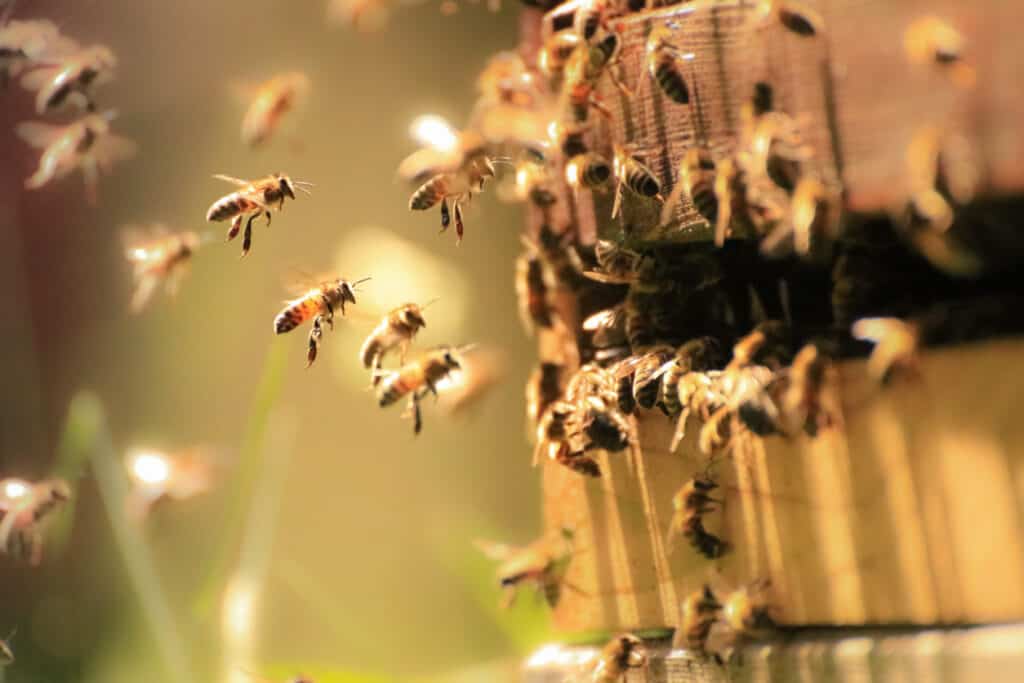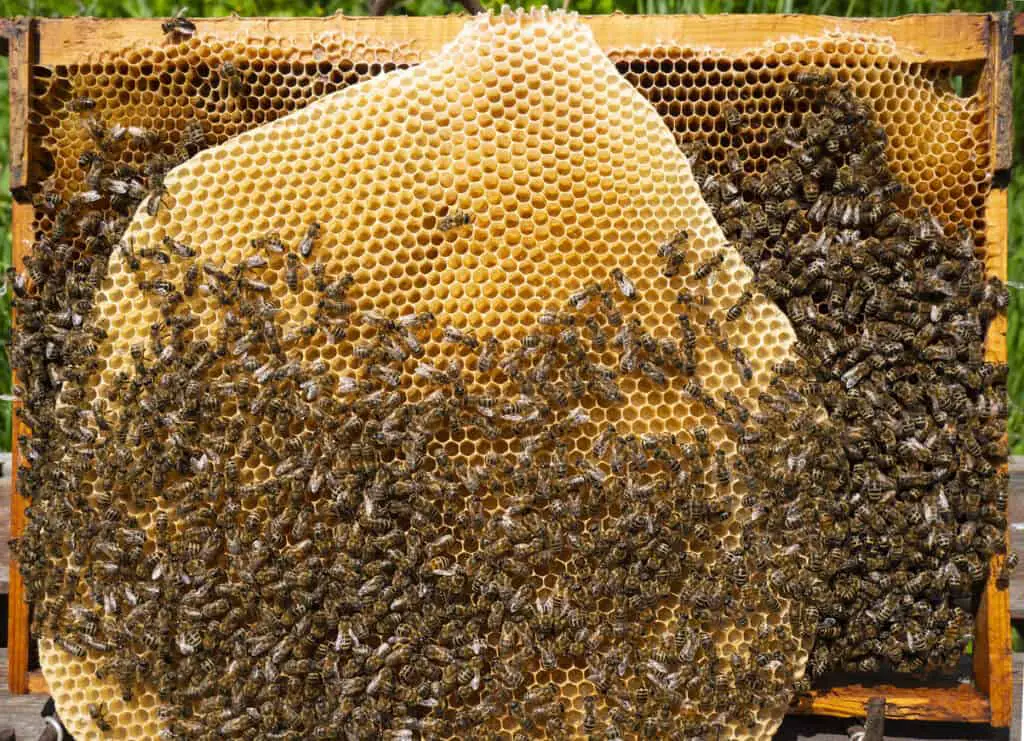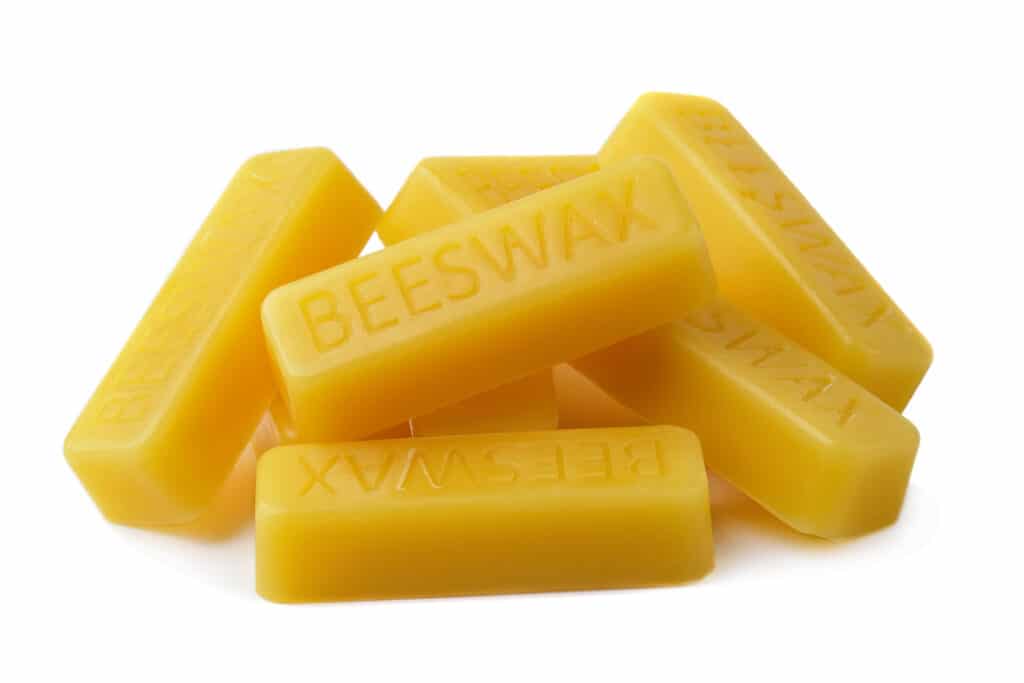There are roughly 25 000 different bee species worldwide, some of which are known for living in large colonies that can house thousands of bees. In the wild, bees live in what we call nests, but some bees opt to live in artificial structures called beehives. With beehives spread worldwide, you might wonder what these hives are made of and how the materials used in their construction might have changed over time.
Beehives include an external housing, which varies and includes objects such as artificial wooden boxes, mud cylinders, clay pots, baskets, hollowed-out tree trunks, and plastic containers. The inside of the beehive consists of densely packed beeswax, called honeycomb, made into hexagonal shapes.

Over the years, beekeepers have used different materials to create suitable beehives to house their bees. Some of these designs have been better than others. There are multiple outer housings that you could choose to make your beehive, including both artificial and natural ones. In modern times most beekeepers use wooden boxes of various designs. Only once you have looked at each external housing in detail can you fully grasp what materials you or your bees could use to make these beehives.
From What Are Beehives Made?

The most straightforward explanation of a beehive is that it is an enclosed structure where bees live and raise their young. Not all bee species opt to live in beehives, and some prefer to live in the ground, while others bore holes into trees.
When describing a beehive, the commonly accepted idea is that it is an artificial structure made by people to house a bee colony. Most people refer to bee colonies in the wild or naturally as nests rather than beehives.
Beekeeping has been around for hundreds if not thousands of years, and the structures used to make them have changed drastically during this period. One thing that does not change is what you will find inside the beehive.
What Do Bees Use To Create The Insides Of Their Beehives?

Bees construct their internal nests out of beeswax, commonly called honeycomb. The worker bees create this wax through excretion with specially designed glands on their abdomens. The worker bees will consume some of their honey, providing them with sugar which they then convert into wax.
Once they have excreted the wax, they use their little feet to take it from their belly. They then chew it some more before forming it into perfect hexagonal cells.
The bees then pack these ingenious hexagonal prismatic cells that they have created out of the beeswax close together to form sheets. These beeswax sheets are the heart and life of the beehive as they house the bees’ food, pollen and honey, and the brood, which you can describe as the bees’ eggs, larvae, and pupae.
Bees have a specific internal layout that they follow to precision. When they lay out their beeswax sheets, also known as honeycomb, in their layers, there is a gap between each one, known as the bee gap, which allows the bees to work effectively in the space.
Bees will also ensure that their beehives are clean and draft-free. They do this by coating the hive’s interior with propolis, a combination of hardened beeswax, plant resins, and saliva.
The bees will also use propolis to block any crevices or gaps, and they also use it at the entrance to the hive to trap any harmful microbes which may be catching a ride on the legs of the foraging bees.
What Materials Are Used To Make The Outside Of A Beehive?
The outer structure of the beehive has varied over time. It includes materials such as mud, clay, woven reed baskets, hollowed-out tree trunks, artificially created wooden boxes, and even in some cases, plastic boxes, although this is not as common.
The wood used for the beehive construction needs to be weatherproof, repel unwanted boring insects, and safe for bees.
The best way to find out what beehives are made of would be to take a more detailed look at their different outer structures.
What Are Some Different Materials Used To Make Beehives?
With honey being such a popular and favorite food source, people have been facilitating its production for hundreds of years. Evidence shows that the ancient Egyptians kept bees as far back as the 5th Dynasty. It’s no wonder the materials used in the construction of beehives have changed and adapted over the years. These adaptations are not only because of new and improved methods but also because of material availability.
Modern Beehives
Today beekeeping is an important farming method used not only to produce the deliciously tasty honey and honeycomb but also because having bees on your farm or close to your crops is a great way to facilitate pollination. Modern beekeeping strives to ensure the safety of their bees, using beehives that they purposefully construct in a way that allows beekeepers to harvest honey without causing harm to the bee colony within.
The setup of these beehives might differ, but they are all typically made of wood. Most beehives in use today are made from wooden boxes with internal hanging frames, which provide a base for the bees to attach their honeycomb. The wood used for these boxes would depend on who made them, which region you live in, and your budget. Let’s look at some of the woods used to make beehives today.
Pine
Pine is the most popular wood used today to make beehives. It is readily available in most areas, relatively inexpensive, and relatively easy to use in woodworking. There are different pine grades, two of which beehive makers use more often in their construction.
- Standard Pine (knotty pine): This is the most cost-effective type of pine. It does contain some knots in the wood, but it is still good to use for beehives. It comes down to whether the beehive makers wish to have an ideally-looking beehive or one with a more rustic appearance, which is what the knotty wood will give you.
- Premium Pine (clear with no knots): This type of pine is more expensive than the knotty kind, but it will give you a better finish. The wood grain also tends to be straighter and tighter.
Spruce And Fir
Some beehive makers make their beehives out of spruce and fir wood. Typically you might see this wood used for the construction of the top bars, frames, and some other beehive pieces. This wood is not as popular as pine.
Cedar
Cedar is another excellent type of wood to use in the construction of a beehive and is also a popular choice. Its popularity is because it is less likely to rot than other woods, less susceptible to bug infiltration, and its natural oils help to prevent it from warping. It also has a beautiful smell and looks pretty. Its only downfall is its price, so you might not see as many beehives made from this wood.
Cypress
Cypress wood is an excellent option for making beehives as its sap-type oil is a natural mold and insect repellent. Unfortunately, cypress is not as readily available in the United States as other woods, so you might not see as many beehives made out of this material.
Traditional Beehives
You can view traditional beehives as those made by people who didn’t have access to modern technology or materials. These traditional beekeepers would often make their beehives in such a way that when it came time to harvest the honey, they would need to destroy the colony to get at the goodness within.
The reason for this destruction was because the focus of traditional beehives was the outer structure, a way to entice the bees to form a colony where their honey would be accessible to outsiders. They made their external structures in a way that did not facilitate the easy removal of the honeycomb. Instead, the bees would have to make their honeycomb within the confines of the beehive, fixing their sheets to the structure, ensuring their destruction.
In some cases, adaptions were made that allowed the bees to attach their honeycomb to removable top baskets, which allowed the beekeepers to remove the honey without destroying the colony. Let’s discuss some materials used in the different traditional beehive construction methods.
Mud Beehives
Users of mud beehives made them out of straw, mud, and dung shaped into long cylinders. These were either hung out of trees or placed on the ground. These types of beehives are still used in Siberia and Egypt today.
Clay Beehives
In the eastern end of the Mediterranean, you could expect to find beehives made of clay tiles. In some places in Italy, Greece, and Malta, you would expect to find beehives made of baked clay shaped into long cylinders. Beekeepers who used these forms of beehives often placed them in rows so that they could provide side shade for each other.
To harvest the honey, the beekeepers would smoke one end of the beehive to drive the bees to the other side while they were at work on the other end.
Skeps
Beehives made out of coils of grass, wicker, or straw and then plastered with dung and mud are what we refer to as skeps. These beehives look like an average basket with one of their ends open. The beekeepers would typically place the skeps open-end down on the ground.
A simple and typical skep would have its entrance at the bottom and would have no internal structures with which the bees could attach their honeycomb. Therefore, the bees would have to connect their honeycomb to the sides of the skep.
Unfortunately, this method of beekeeping has a few disadvantages. Firstly, the beekeepers would be unable to check the comb for any pests or diseases. Secondly, harvesting the honey from this setup was difficult and often led to the colony’s destruction.
In many cases, the bees were removed from the hive using sulfur, killing any bees in the vicinity. The beekeepers would then remove the honey from the beehive. In other cases, the beekeepers would use a bottom extension referred to as an eke or a top extension referred to as a cap in which they tried to create a situation where the bees would produce a comb with only honey.
It is not surprising that the USA prohibited this method of beekeeping in 1998. This prohibition included all beehives made in a way that resulted in the beekeepers being unable to inspect them for pests and parasites.
Bee Gums
In places like the eastern United States, beekeepers made their hives out of sections of trees that they hollowed out, and they called these bee gums. These beehives acquired their name because beekeepers typically used black gum trees for their construction.
Beekeepers constructed these hives and placed them in apiaries or “bee yards.” In some cases, the beekeepers would establish a board with sticks for the bees to attach their honeycomb.
When it came to harvest time, beekeepers would typically destroy the colony during harvesting. Sometimes, they would insert a metal container containing burning sulfur into the hive before starting the harvest, killing all the bees in the gum first.
Beekeepers in Central Europe used a similar setup for their beehives, using both artificial hollowed-out trunks of trees and trees that had naturally occurring hollows. Luckily for these bee colonies harvesting the honey did not necessitate the colony’s destruction. Instead, the beekeepers used a protective piece of wood over the opening, which they would remove, smoke the bees to calm them, and harvest the honey.
The First Known Beehives
Archaeologists have found evidence of ancient beehives from a range of different places. In the ruins of Rehov, an ancient city occupied by the Canaanites and Israelites, they found beehives constructed out of straw and unbaked clay.
Natural Beehives
Beehives found out in the wild or that bees have constructed without using artificial means are made from various materials. Bees will use any crevice they deem safe enough to house their colony, including hollow trees, rock cavities, or caves. They will happily use stacks of wood, abandoned cars, or anywhere they can attach their honeycomb.
A bee colony might occupy the same nest for several years; during this time, they will make it as homely as possible. If you came across one of these nests, you might notice that the bee occupants had smoothed the bark surrounding their entrance and coated the walls with a thin layer of propolis.
Conclusion
When it comes to the internal structure of a beehive, you can be sure that you will find densely packed layers of honeycomb that house the bees’ food and brood. When it comes to the external structure of the beehive, the materials used will vary depending on whether the beehive is natural or artificial. The materials used to make artificial beehives have changed drastically from straw and mud to clay cylinders, bee gums, and wooden boxes.
References
https://en.wikipedia.org/wiki/Beehive
https://www.orkin.com/pests/stinging-pests/bees/honey-bees/how-do-honey-bees-make-hives
https://teca.apps.fao.org/teca/fr/technologies/7273
https://www.quora.com/What-are-beehives-made-of-How-are-they-made
https://www.dkfindout.com/us/animals-and-nature/insects/where-do-bees-live/
https://animals.mom.com/difference-between-bumblebees-honeybees-4447.html
https://byjus.com/question-answer/from-which-material-is-the-honey-bee-hive-made/

